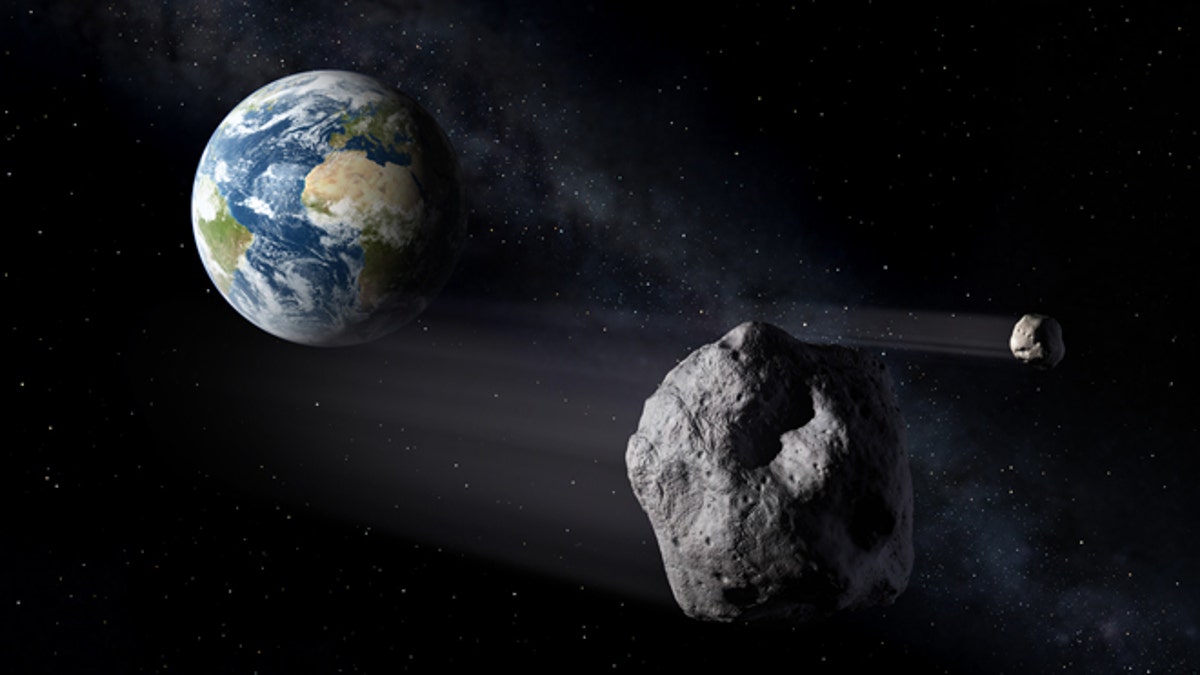Fox News Flash top headlines for Dec. 3
Fox News Flash top headlines for Dec. 3 are here. Check out what's clicking on Foxnews.com
The European Space Agency has received approval to aid NASA in its asteroid deflection plan, the upcoming Double Asteroid Redirection Test (DART) mission.
According to the ESA's website, the European space ministers have approved the agency's plan to build and launch the Hera spacecraft, which will visit the Didymos asteroid system. NASA's DART spacecraft is slated to collide with the smaller Didymoon asteroid, which orbits Didymos, sometime near the end of 2022.
Didymoon's diameter is roughly 525 feet (160 meters), according to NASA, whereas the larger Didymos is approximately 2,560 feet wide. Both are considered "potentially hazardous" near-Earth objects.

An artist's illustration of asteroids, or near-Earth objects, that highlight the need for a complete Space Situational Awareness system. (ESA - P.Carril)
NASA GAMEPLANS MASSIVE ASTEROID STRIKE
"Potentially hazardous" NEOs are defined as space objects that come within 0.05 astronomical units and measure more than 460 feet in diameter, according to the U.S. space agency.
"Hera will be humanity's first-ever spacecraft to visit a double asteroid, the Didymos binary system," the ESA wrote on its website.
The ESA added: "Hera's up-close observations will turn asteroid deflection into a well-understood planetary defense technique." A video was also posted to the agency's YouTube page providing more detail.
The current plan is for DART to launch aboard a SpaceX rocket in the middle of 2021, ultimately crashing into Didymoon toward the end of 2022. If successful, Hera would launch in 2024 and arrive by 2026 to inspect the findings. The ESA added Hera would "map the resulting impact crater and measure the asteroid's mass."
It will also have CubeSats on board that will be able to get closer to the asteroid's surface, carry out studies and ultimately, touch down on its surface.
In April, NASA awarded a $69 million contract to SpaceX, the space exploration company led by Elon Musk, to help it with asteroid deflection via its DART mission. Separately that month, the ESA announced that it was developing a self-driving craft for Hera.
NASA has recently expanded its planetary defense protocols, including last year's unveiling of a bold new plan to protect Earth.
ANCIENT ASTEROID STRIKES ON MARS MAY HAVE 'PRODUCED KEY INGREDIENTS FOR LIFE'
Last June, NASA unveiled a 20-page plan that details the steps the U.S. should take to be better prepared for NEOs such as asteroids and comets that come within 30 million miles of the planet.
Lindley Johnson, NASA’s planetary defense officer, said at the time that the country "already has significant scientific, technical and operational capabilities" to help with NEOs, but implementing the new plan would "greatly increase our nation’s readiness and work with international partners to effectively respond should a new potential asteroid impact be detected.”
In addition to enhancing NEO detection, tracking and characterizing capabilities and improving modeling prediction, the plan also aims to develop technologies for deflecting NEOs, increasing international cooperation and establishing new NEO impact emergency procedures and action protocols.
Separately in April, NASA Administrator Jim Bridenstine said that an asteroid strike is not something to be taken lightly and is perhaps Earth's biggest threat.
"We have to make sure that people understand that this is not about Hollywood, it's not about movies," Bridenstine said at the International Academy of Astronautics' 2019 Planetary Defense Conference in College Park, Md., according to Space.com. "This is about ultimately protecting the only planet we know right now to host life, and that is the planet Earth."
According to a 2018 report put together by Planetary.org, there are more than 18,000 NEOs.





















